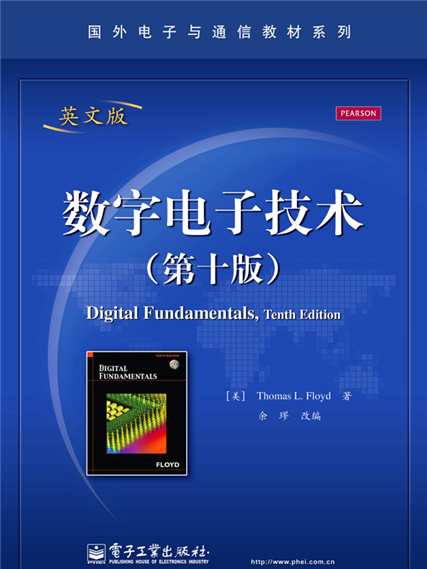內容簡介
本書是一本關於數字電子技術的經典教材,並專門針對國內教學的實際情況進行了縮減。全書主要介紹了數字電子技術的基本概念、數制、邏輯門、布爾代數和邏輯化簡、組合邏輯分析、組合邏輯的作用、計數器、
移位暫存器、存儲器、可程式邏輯與軟體、積體電路技術等。全書的特色在於示例與習題豐富、圖解清晰、語言流暢、寫作風格簡約。
圖書目錄
CONTENTS
Chapter 1 Introductory Concepts 1
1–1 Digital and Analog Quantities 1
1–2 Binary Digits, Logic Levels, and Digital Waveforms 3
1–3 Fixed-Function Integrated Circuits 8
Chapter 2 Number Systems, Operations, and Codes 16
2–1 Decimal Numbers 16
2–2 Binary Numbers 17
2–3 Decimal-to-Binary Conversion 20
2–4 Binary Arithmetic 22
2–5 1’s and 2’s Complements of Binary Numbers 26
2–6 Signed Numbers 27
2–7 Arithmetic Operations with Signed Numbers 33
2–8 Hexadecimal Numbers 39
2–9 Octal Numbers 45
2–10 Binary Coded Decimal (BCD) 47
2–11 Digital Codes 50
2–12 Error Detection Codes 52
Chapter 3 Logic Gates 66
3–1 The Inverter 66
3–2 The AND Gate 68
3–3 The OR Gate 75
3–4 The NAND Gate 79
3–5 The NOR Gate 83
3–6 The Exclusive-OR and Exclusive-NOR Gates 87
3–7 Fixed-Function Logic 90
Chapter 4 Boolean Algebra and Logic Simplification 110
4–1 Boolean Operations and Expressions 110
4–2 Laws and Rules of Boolean Algebra 111
4–3 DeMorgan’s Theorems 116
4–4 Boolean Analysis of Logic Circuits 119
4–5 Simplification Using Boolean Algebra 122
4–6 Standard Forms of Boolean Expressions 125
4–7 Boolean Expressions and Truth Tables 131
4–8 The Karnaugh Map 135
4–9 Karnaugh Map SOP Minimization 137
4–10 Five-Variable Karnaugh Maps 147
System Application Activity 149
Chapter 5 Combinational Logic Analysis 163
5–1 Basic Combinational Logic Circuits 163
5–2 Implementing Combinational Logic 168
5–3 The Universal Property of NAND and NOR Gates 173
5–4 Combinational Logic Using NAND and NOR Gates 175
5–5 Logic Circuit Operation with Pulse Waveform Inputs 180
System Application Activity 183
Chapter 6 Functions of Combinational Logic 197
6–1 Basic Adders 197
6–2 Parallel Binary Adders 200
6–3 Ripple Carry Versus took-Ahead Adders 206
6–4 Comparators 210
6–5 Decoders 213
6–6 Encoders 221
6–7 Code Converters 225
6–8 Multiplexers (Data Selectors) 228
6–9 Demultiplexers 236
6–10 Parity Generators/Checkers 237
System Application Activity 240
Chapter 7 Latches, Flip-Flops, and Timers 260
7–1 Latches 260
7–2 Edge-Triggered Flip-Flops 266
7–3 Flip-Flops Operating Characteristics 277
7–4 Flip-Flops Applications 279
7–5 One-Shots 283
7–6 The Astable Multivibrator 291
System Application Activity 294
Chapter 8 Counters 308
8–1 Asynchronous Counters 308
8–2 Synchronous Counters 316
8–3 Up/Down Synchronous Counters 322
8–4 Design of Synchronous Counters 326
8–5 Cascaded Counters 335
8–6 Counter Decoding 338
8–7 Counter Applications 342
8–8 Logic Symbols with Dependency Notation 346
System Application Activity 348
Chapter 9 Shift Registers 363
9–1 Basic Shift Register Operations 363
9–2 Serial In/Serial Out Shift Registers 364
9–3 Serial In/Parallel Out Shift Registers 368
9–4 Parallel In/Serial Out Shift Registers 370
9–5 Parallel In/Parallel Out Shift Registers 374
9–6 Bidirectional Shift Registers 375
9–7 Shift Register Counters 378
9–8 Shift Register Applications 381
9–9 Logic Symbols with Dependency Notation 389
System Application Activity 390
Chapter 10 Memory and Storage 402
10–1 Memory Basics 402
10–2 The Random-Access Memory (RAM) 406
10–3 The Read-Only Memory (RAM) 419
10–4 Programmable ROMs 423
10–5 The Flash Memory 426
10–6 Memory Expamsion 430
10–7 Special Types of Memories 436
10–8 Magnetic and Optical Storage 441
System Application Activity 447
Chapter 11 Signal Interfacing and Processing 458
11–1 Converting Analog Signals to Ditital 458
11–2 Analog-to-Digital Conversion Methods 464
11–3 Digital-to-Analog Conversion Methods 475
11–4 Digital Signal Processing Basics 483
Chapter 12 Integrated Circuit Technologies 491
12–1 Basic Operational Characteristics and Parameters 491
12–2 CMOS Circuits 498
12–3 TTL (Bipolar) Circuits 503
12–4 Practical Considerations in the Use of TTL. 508
12–5 Comparison of CMOS and TTL Performance 515
12–6 Emitter-Coupled Logic (ECL) Circuits 516
12–7 PMOS, NMOS, and E2CMOS 518
Appendix A Karnaugh Map POS Minimization 529
Appendix B The Quine-McCluskey Method 533
Appendix C NI Multisim for Circuit Simulation 536
Answers to Odd-Numbered Problems 541

